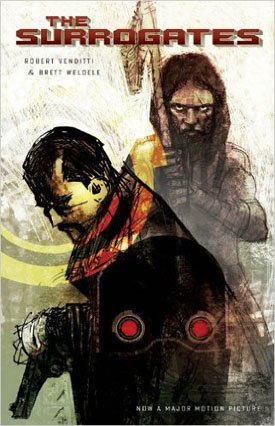 Robert Venditti’s The Surrogates, drawn by Brett Weldele, is right up among the top graphic works I’ve run across recently. Set in a near-future megalopolis, it’s a fast-moving crime drama with a couple of unique twists.
Robert Venditti’s The Surrogates, drawn by Brett Weldele, is right up among the top graphic works I’ve run across recently. Set in a near-future megalopolis, it’s a fast-moving crime drama with a couple of unique twists.
The central motivator in the story, which takes place in the Central Georgia Metropolis in 2054, is the advent of surrogates, a combination of robotics and artificial intelligence that allows people to move through life without personal risk: surrogates act as remote bodies, with sensory feedback hookups so that the owner/operator is “there.” Fifteen years before this story begins, there had been anti-surrogate riots, led by Zaire Powell III, known to his followers as “The Prophet.” The Prophet and his followers now occupy a reserve at some distance from the city center, and he still preaches against the surrogates.
And now, there is something going around destroying surrogates by electrocuting them. It is successful in stealing a prototype of a new chip that not only offers advanced features for surrogates, but solves some of the existing problems. And then this — person, or whatever it is — steals a disc with the software for the chip. Detective Harvey Greer and Sergeant Pete Ford find themselves with a nightmare case on their hands: a techno-terrorist who, it seems, is using a souped-up surrogate to acquire the means to destroy all surrogates.
The story is a good one, lean, fast, and gritty enough to count as noir detective fiction in a well-executed science-fiction milieu. The book includes additions after each chapter — an article from a cybernetics journal, the transcript of an interview with The Prophet, a newspaper article on the accord reached at the end of the riots, and ads for Virtual Self, the manufacturer of the surrogates, that add a sense of reality to the whole thing.
Characterizations are firm, although there’s not a lot of room in the story for development. Greer’s ambivalent attitude toward surrogates surfaces in arguments with his wife after he decides to work the case in his own body — after his surrogate has a run-in with the perpetrator. He decides that maybe the Prophet was right, although he still doesn’t agree with his methods, and that people should live their own lives first-hand. There isn’t a lot of subtlety here, however: Greer’s dialogue is pretty much flat out exposition in those sections, which does detract from the mood.
The graphics here are amazing. Weldele’s drawing has a rough-sketch quality — something like the preliminary work of a police artist — that supports the body of the work beautifully, and we are saved from the “cartoon color” so often found in graphic works by the extensive use of overall tones. He’s used both manual and digital means to develop the images, giving excellent body and depth to each frame, and sequences have a color signature that supports the mood. It’s hard to describe, but the colors, mainly variations on brown, blue and gray, have a high measure of depth and richness without that stop-at-the-surface quality so often evident in American comics. Nor has Weldele rendered each figure in each frame as a complete, highly finished image: distance and motion will result in a sketchy, loose rendering that once again is perfectly in keeping with the thrust of the narrative.
The bonus section is that: a real bonus. We’re treated to a gallery of the covers of the individual numbers; a sample of the script with a short paragraph by Venditti commenting on the development of the script into finished visuals, and including samples of Weldele’s roughs and the work in process, with notes on the various means (manual and digital) used to produce the final art; a section on the VSI “ad campaign” and how it was developed (and it’s amazing — just like any ads you’d find in an upscale magazine); and a gallery of character renderings by various artists.
The Surrogates is an excellent example of what’s possible in comics, and it’s refreshing to see something in this medium that abandons most of the clichés. I’m going to be keeping my eyes peeled for more by Venditti and Weldele.
(Top Shelf Productions, 2006)
